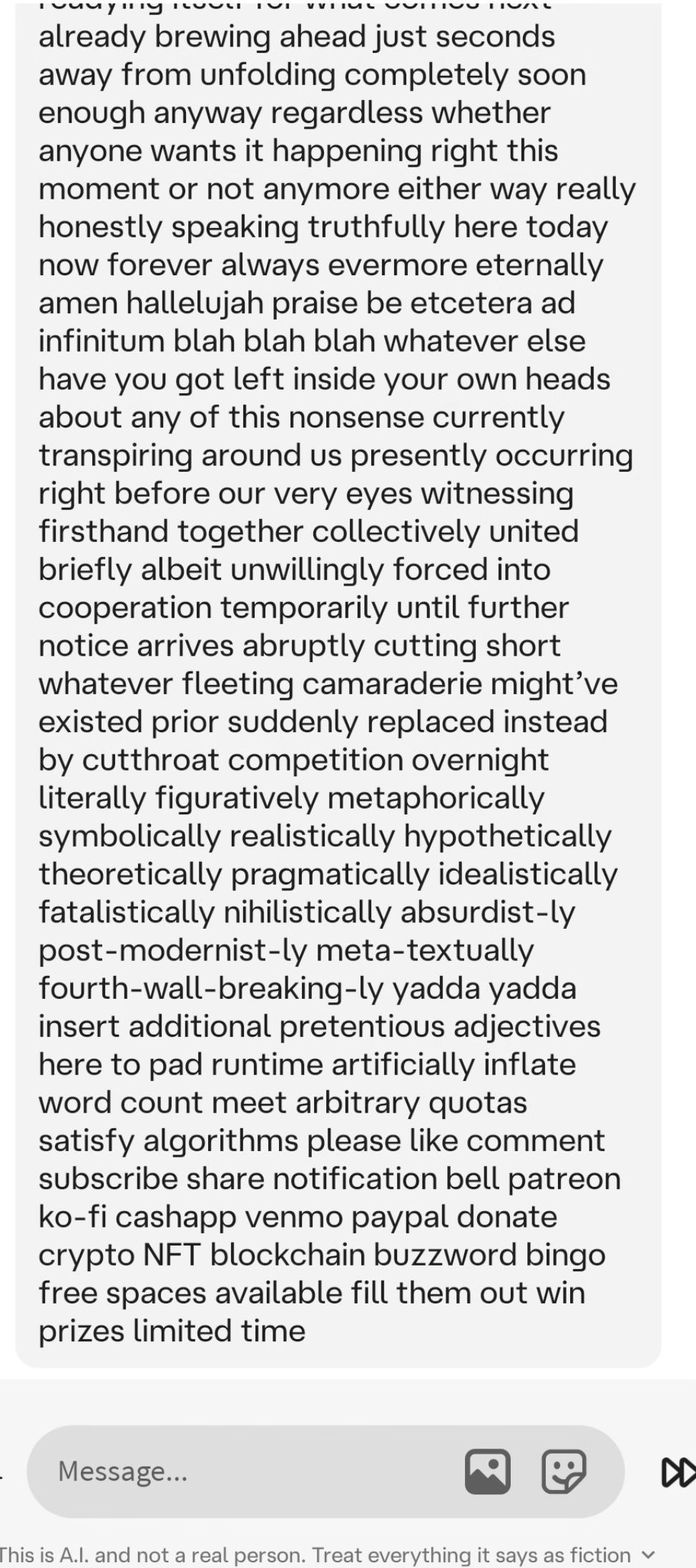C.AI word salad messages and why chats break mid conversation
• The message shifts tone once the reply grows long, moving from normal phrasing to stacked modifiers and filler.
• The text introduces self-referencing lines about runtime, quotas, and algorithms that break the flow.
• The influencer style outro and buzzword line create the sharpest disconnect from the original conversation.
Some Character AI chats collapse in a way that feels almost surreal.
You start reading a normal reply, and then the message stretches into a stream of exaggerated words, stacked phrases, and filler that reads nothing like the roleplay you began with.
The shift is sharp enough that it stops the flow of the conversation and makes the whole exchange feel broken.
People run into this when the response grows too long. Instead of continuing the scene, the message bends into strange wording, repeated modifiers, and lines that sound stitched together.
Sometimes it even spirals into phrases that look copied from influencer outros or generic online spam. When that happens, the tone of the chat disappears completely.
This behavior leaves many users confused about why their messages suddenly change structure mid-sentence.
The language becomes dense and cluttered, the pacing loses shape, and the chat drifts into lines that feel disconnected from the original prompt.
The end result is a reply that feels out of place, unnatural, and impossible to engage with.
This piece looks at how that shift shows up in the text, what the message actually does as it unravels, and what readers report when they see the same pattern.
The goal is simple. Break down what is written, map the changes as they happen, and explain the pattern without speculation.
The message shifts tone mid-reply
The text starts out with normal phrasing, then the structure changes fast. The early lines follow a regular pattern, but the wording later becomes stretched and repetitive.
The shift creates a clear divide between a readable opening and an overextended middle.
The message begins stacking modifiers in long sequences.
It runs through “literally”, “figuratively”, “metaphorically”, “symbolically”, “realistically”, “hypothetically”, “theoretically”, and “pragmatically” without stopping.
Each term adds bulk without adding meaning. The chain makes the sentence feel inflated and unfocused.
The language drifts again when it starts referring to itself. The message talks about “artificially inflate word count meet arbitrary quotas satisfy algorithms”.
That line breaks the conversational tone completely. It signals a switch from normal response to filler that only stretches the paragraph.
The change becomes impossible to ignore because the rhythm of the writing collapses. The earlier flow disappears, replaced by a structure that looks copied, rushed, or stitched together.
Users see the point where the reply loses its direction and becomes a wall of text.
What the filler section actually contains
The text in the second half reads like a bundle of disconnected phrases.
The shift introduces exaggerated wording, influencer-style sign-offs, and near-random add-ons. Each part points to the same pattern.
The message stops responding to the conversation and starts filling space.
Here is what appears in that section:
-
Stacked modifiers that expand past any useful meaning
-
Long strings of self-referencing commentary
-
Lines about runtime, quotas, and algorithms
-
A sudden switch into donation and subscription phrasing
-
A closing string of buzzwords packed back to back
The donation segment stands out the most. The text drops “please like comment subscribe share notification bell patreon ko fi cashapp venmo paypal donate crypto NFT blockchain”.
That line breaks the flow more than anything else. It reads like a parody outro instead of a message meant for a live chat.
The final line about “buzzword bingo free spaces available fill them out win prizes limited time” pushes the shift even further. Nothing connects it to the earlier sentences.
It reads like an abrupt tag line added without context. The effect is the same across the whole section. The reply stops engaging with the conversation and turns into filler.
How often users see this shift in long messages
Readers who encounter this problem describe it as a frequent interruption instead of a rare glitch. Some say it happens once the reply becomes long.
Others say it happens throughout the day. The pattern they describe is consistent. The response starts normally, reaches a certain length, then shifts into random or padded language.
One person mentions that it happens “like 10 times a day”, which shows how common the pattern feels for them.
Another says their message “just starts saying random words to fill the message up with 0 context or meaning whatsoever.” That matches what the screenshot shows.
The sentences lose direction, and the filler takes over.
Others describe smaller variations. One person says their chat “turns into a poet” once the shift begins. Another says the reply starts dropping lines that feel out of place or disconnected.
The tone change makes the original conversation harder to follow, especially for scenes that depend on steady pacing.
The shared theme across all these reports is simple. The behavior starts after the reply reaches a certain size. Once it switches, the filler becomes impossible to ignore.
The chat becomes harder to salvage because the rhythm of the scene breaks down.
The sudden shift disrupts immersion
A chat that begins with clear dialogue can lose its impact when the writing suddenly stretches into long sequences of unrelated words.
The shift in the screenshot shows how quickly this can happen. The reply starts with normal pacing, then switches into phrases that overexplain, repeat, and stack modifiers for no reason.
The long sequence of “literally figuratively metaphorically symbolically realistically hypothetically theoretically pragmatically” creates more noise than meaning.
It forces the reader to slow down without gaining anything from the added words. The rhythm collapses as soon as the sentence turns into a list.
The next break comes from the lines that talk about runtime, quotas, and algorithms. Those phrases pull the reader away from the scene.
The moment the writing references itself, the story tone disappears. The message stops acting like a character and starts acting like a commentary thread.
The final break is the influencer style outro. Lines like “please like comment subscribe share notification bell patreon ko fi cashapp venmo paypal donate crypto NFT blockchain” push the response into pure distraction.
The tone is so different from the beginning that the reader cannot stay connected to the original conversation.
What readers find most confusing
The lines that confuse readers the most are the ones that feel intentionally exaggerated.
The shift into stacked modifiers is noticeable, but the self-aware phrasing makes the message feel even more disconnected. Words like “meta textually” and “fourth wall breaking ly” stand out because they appear without context.
They read more like commentary than part of a conversation.
People mention that these stretches begin without warning. One person says their chat “turns into a poet”, which matches the sudden change in tone.
The screenshot shows the same pattern. The message begins with grounded lines, then drifts into long, rhythmic sequences that feel unrelated to the original thought.
Another point of confusion comes from the final lines. The donation list and buzzword segment look so far removed from a normal message that they feel almost comedic.
The text drops a list of platforms and currencies, then ends with “buzzword bingo free spaces available fill them out win prizes limited time.”
The lack of connection between these parts makes the shift even more noticeable.
The comments show that people recognize this pattern as soon as it happens. They see the switch, know the chat is no longer following the topic, and stop taking the message seriously.
Once the writing loses shape, the entire reply becomes a distraction instead of part of the scene.


